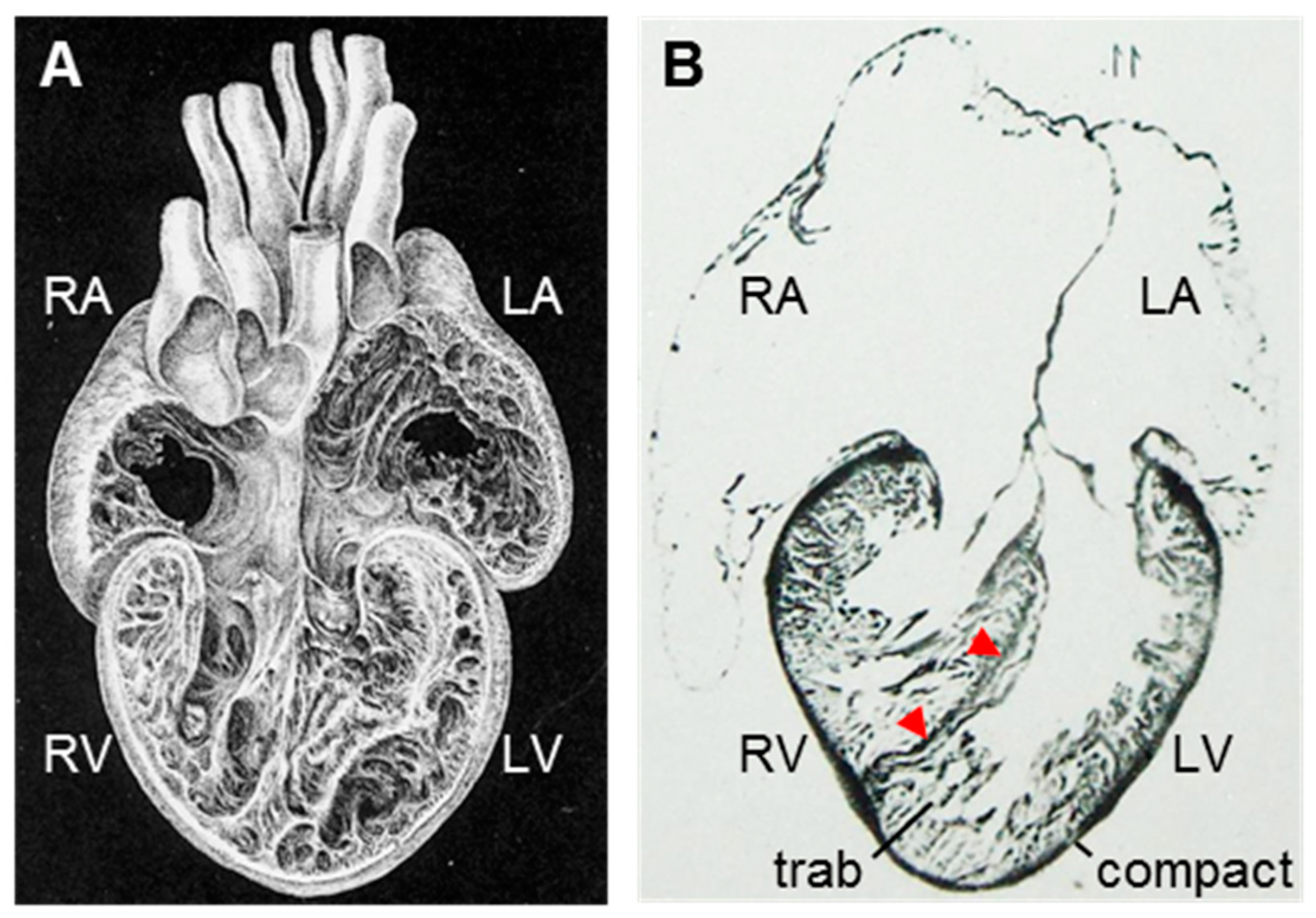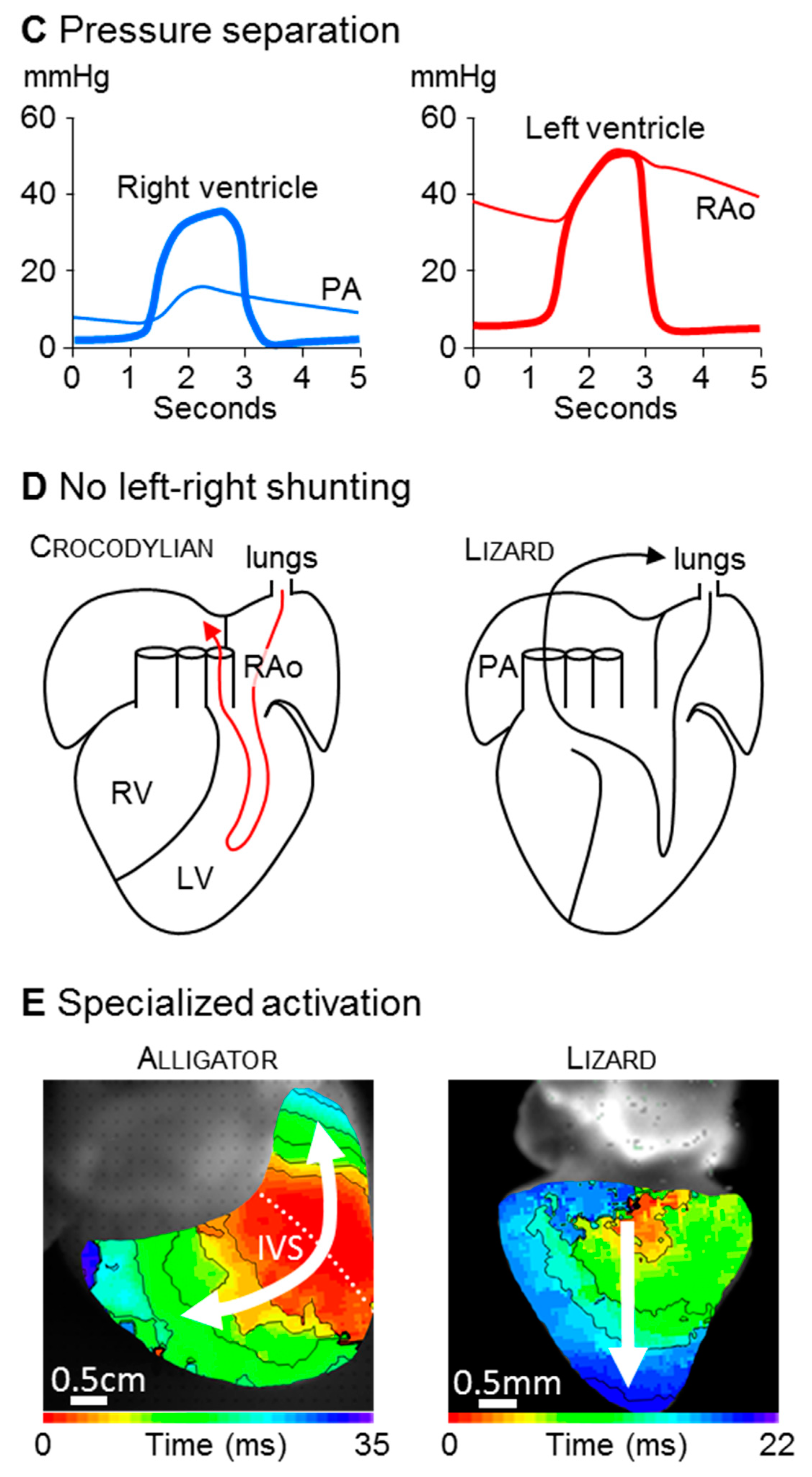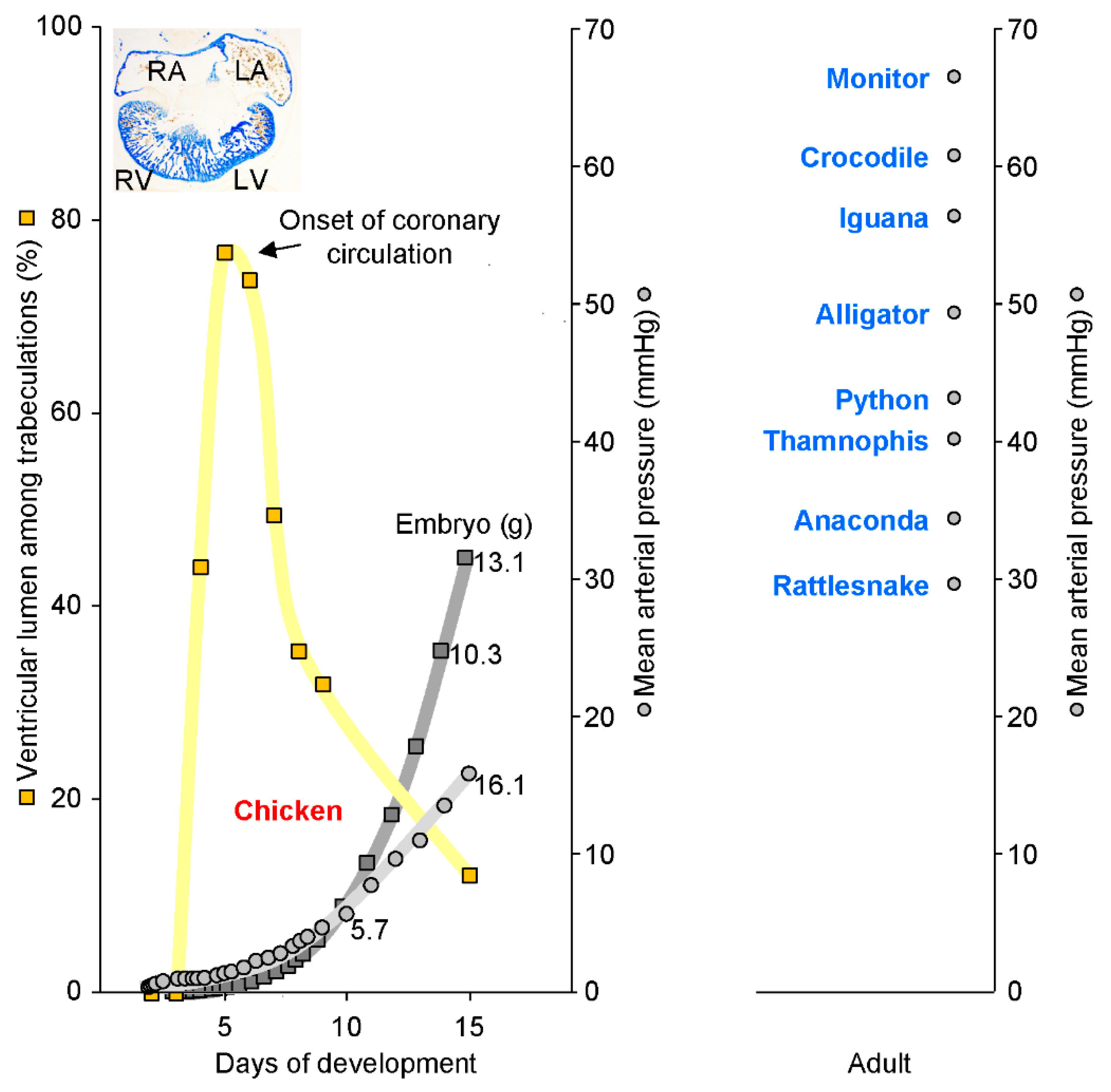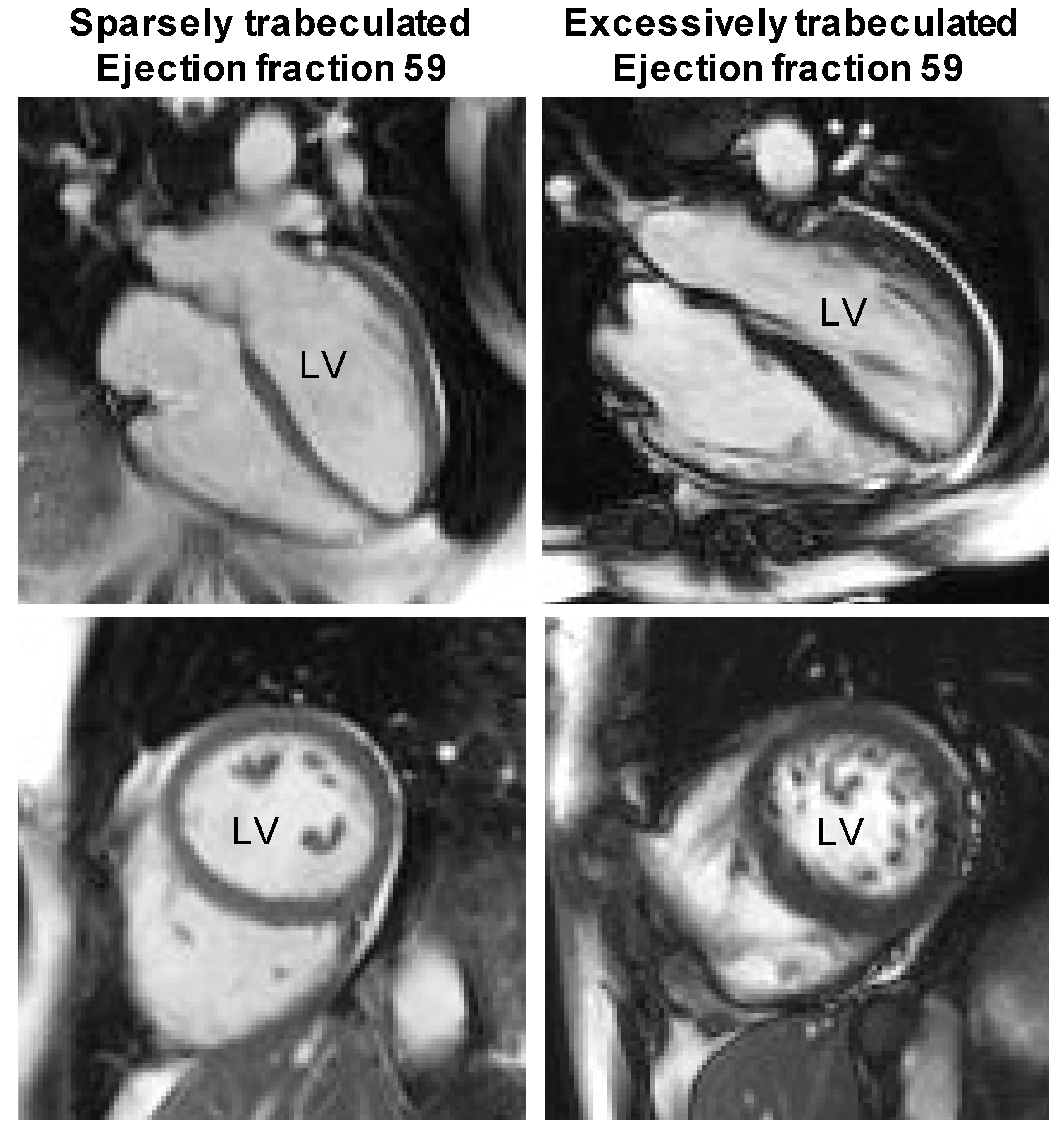Examples of Weak, If Not Absent, Form-Function Relations in the Vertebrate Heart
Abstract
1. Introduction
- Mechanism (material cause), how does it work?Example: The heart pumps blood.
- Function (finale cause), why does it work?Example: because it perfuses the tissues with blood.
- Ontogeny (formal cause), how is it made?Example: cardiogenic mesoderm surrounds a blood-filled cavity.
- Phylogeny (efficient cause), why did it evolve?Example: the propulsion of blood through the tissues compensates for the increased diffusion distance between tissue and environment associated with greater body sizes.
2. Cases
2.1. One Form and Multiple Functions–Which Mechanism (Material Cause)?
The Curious Case of the Crocodylian Heart
2.2. Ontogeny (Formal Cause): When Is Form and Function Related?
2.3. Form Unrelated to Function: No Final Cause?
Trabeculation of the Left Ventricle of Adult Humans
2.4. Relationship between Form and Function in Evolution (Efficient Cause)?
Ventricular Trabeculations in Vertebrates
2.5. Can A Reduction in Energy Expenditure Have A Structural Consequence?
The Outflow Tract of the Fish Heart
2.6. Lungs, Then Heart
Can Loss of the Lungs Impact on Cardiac Septation?
3. Synthesis
Funding
Acknowledgments
Conflicts of Interest
References
- Sizarov, A.; Anderson, R.H.; Christoffels, V.M.; Moorman, A.F. Three-dimensional and molecular analysis of the venous pole of the developing human heart. Circulation 2010, 122, 798–807. [Google Scholar] [CrossRef] [PubMed]
- Webb, S.; Kanani, M.; Anderson, R.H.; Richardson, M.K.; Brown, N.A. Development of the human pulmonary vein and its incorporation in the morphologically left atrium. Cardiol. Young 2001, 11, 632–642. [Google Scholar] [CrossRef] [PubMed]
- Kato, R.; Lickfett, L.; Meininger, G.; Dickfeld, T.; Wu, R.; Juang, G.; Angkeow, P.; LaCorte, J.; Bluemke, D.; Berger, R.; et al. Pulmonary vein anatomy in patients undergoing catheter ablation of atrial fibrillation: Lessons learned by use of magnetic resonance imaging. Circulation 2003, 107, 2004–2010. [Google Scholar] [CrossRef] [PubMed]
- Prasanna, L.C.; Praveena, R.; D’Souza, A.S.; Kumar, M.R. Variations in the pulmonary venous ostium in the left atrium and its clinical importance. J. Clin. Diagn. Res. 2014, 8, 10–11. [Google Scholar]
- Gould, S.J.; Lewontin, R.C. The spandrels of San Marco and the Panglossian paradigm: A critique of the adaptationist programme. Proc. R. Soc. Lond. 1979, 205B, 581–598. [Google Scholar] [CrossRef]
- Krogh, A. The progress of physiology. Am. J. Physiol. 1929, 90, 243–251. [Google Scholar]
- Smerup, M.; Damkjaer, M.; Brondum, E.; Baandrup, U.T.; Kristiansen, S.B.; Nygaard, H.; Funder, J.; Aalkjaer, C.; Sauer, C.; Buchanan, R.; et al. The thick left ventricular wall of the giraffe heart normalises wall tension, but limits stroke volume and cardiac output. J. Exp. Biol. 2016, 219, 457–463. [Google Scholar] [CrossRef] [PubMed]
- Martill, D.M.; Tischlinger, H.; Longrich, N.R. A four-legged snake from the Early Cretaceous of Gondwana. Science 2015, 349, 416–419. [Google Scholar] [CrossRef] [PubMed]
- Kerkkamp, H.M.; Kini, R.M.; Pospelov, A.S.; Vonk, F.J.; Henkel, C.V.; Richardson, M.K. Snake Genome Sequencing: Results and Future Prospects. Toxins 2016, 8, 360. [Google Scholar] [CrossRef] [PubMed]
- Jensen, B.; Vesterskov, S.; Boukens, B.J.; Nielsen, J.M.; Moorman, A.F.M.; Christoffels, V.M.; Wang, T. Morpho-functional characterization of the systemic venous pole of the reptile heart. Sci. Rep. 2017, 7, 6644. [Google Scholar] [CrossRef] [PubMed]
- Greil, A. Beitrage zur vergelichenden anatomie und entwicklungsgeschichte des herzens und des trauncus arteriosus der wirbelthiere. Morph. Jahrbuch 1903, 31, 123–310. [Google Scholar]
- Webb, G.J.W. Comparative cardiac anatomy of the reptilia III. The heart of crocodilians and an hypothesis on the completion of the interventricular septum of crocodilians and birds. J. Morphol. 1979, 161, 221–240. [Google Scholar] [CrossRef]
- Cook, A.C.; Tran, V.H.; Spicer, D.E.; Rob, J.M.H.; Sridharan, S.; Taylor, A.; Anderson, R.H.; Jensen, B. Sequential segmental analysis of the crocodilian heart. J. Anat. 2017. [Google Scholar] [CrossRef] [PubMed]
- Jensen, B.; Boukens, B.J.; Crossley, D.A.; Conner, J.; Mohan, R.A.; van Duijvenboden, K.; Postma, A.V.; Gloschat, C.R.; Elsey, R.M.; Sedmera, D.; et al. Specialized impulse conduction pathway in the alligator heart. eLife 2018, 7, e32120. [Google Scholar] [CrossRef] [PubMed]
- White, F.N. Central vascular shunts and their control in reptiles. Fed. Proc. 1970, 29, 1149–1153. [Google Scholar] [PubMed]
- Grigg, G.C.; Johansen, K. Cardiovascular Dynamics in Crocodylus-Porosus Breathing Air and During Voluntary Aerobic Dives. J. Comp. Physiol. B 1987, 157, 381–392. [Google Scholar] [CrossRef]
- Axelsson, M. The crocodilian heart; more controlled than we thought? Exp. Physiol. 2001, 86, 785–789. [Google Scholar] [CrossRef] [PubMed]
- Perry, S.F. Gas exchange strategy in the Nile crocodile: A morphometric study. J. Comp. Physiol. B 1990, 159, 761–769. [Google Scholar] [CrossRef]
- Franklin, C.E.; Axelsson, M. An actively controlled heart valve. Nature 2000, 406, 847–848. [Google Scholar] [CrossRef] [PubMed]
- Axelsson, M.; Franklin, C.E. From Anatomy to Angioscopy: 164 Years of Crocodilian Cardiovascular Research, Recent Advances, and Speculations. Comp. Biochem. Physiol. Part A 1997, 118, 51–62. [Google Scholar] [CrossRef]
- Hicks, J.W.; Wang, T. The Functional Significance of the Reptilian Heart: New Insights into an Old Question. In Ontogeny and Phylogeny of the Vertebrate Heart; Sedmera, D., Wang, T., Eds.; Springer Science+Business Media: Berlin, Germany, 2012; pp. 207–227. [Google Scholar]
- Christian, E.; Grigg, G.C. Electrical activation of the ventricular myocardium of the crocodile Crocodylus johnstoni: A combined microscopic and electrophysiological study. Comp. Biochem. Physiol. A 1999, 123, 17–23. [Google Scholar] [CrossRef]
- Jensen, B.; Boukens, B.J.; Postma, A.V.; Gunst, Q.D.; van den Hoff, M.J.; Moorman, A.F.; Wang, T.; Christoffels, V.M. Identifying the evolutionary building blocks of the cardiac conduction system. PLoS ONE 2012, 7, e44231. [Google Scholar] [CrossRef] [PubMed]
- Eme, J.; Gwalthney, J.; Owerkowicz, T.; Blank, J.M.; Hicks, J.W. Turning crocodilian hearts into bird hearts: Growth rates are similar for alligators with and without right-to-left cardiac shunt. J. Exp. Biol. 2010, 213, 2673–2680. [Google Scholar] [CrossRef] [PubMed]
- Leite, C.A.C.; Taylor, E.W.; Wang, T.; Abe, A.S.; de Andrade, D.O.V. Ablation of the ability to control the right-to-left cardiac shunt does not affect oxygen consumption, specific dynamic action or growth in rattlesnakes, Crotalus durissus. J. Exp. Biol. 2013, 216, 1881–1889. [Google Scholar] [CrossRef] [PubMed]
- Gleeson, T.T.; Mitchell, G.S.; Bennett, A.F. Cardiovascular responses to graded activity in the lizards Varanus and Iguana. Am. J. Physiol. 1980, 8, R174–R179. [Google Scholar] [CrossRef] [PubMed]
- Farmer, C.G.; Carrier, D.R. Ventilation and gas exchange during treadmill locomotion in the American alligator (Alligator mississippiensis). J. Exp. Biol. 2000, 203 Pt 11, 1671–1678. [Google Scholar]
- Seymour, R.S.; Bennett-Stamper, C.L.; Johnston, S.D.; Carrier, D.R.; Grigg, G.C. Evidence for endothermic ancestors of crocodiles at the stem of archosaur evolution. Physiol. Biochem. Zool. 2004, 77, 1051–1067. [Google Scholar] [CrossRef] [PubMed]
- Jensen, B.; Larsen, C.K.; Nielsen, J.M.; Simonsen, L.S.; Wang, T. Change of cardiac function, but not form, in postprandial pythons. Comp. Biochem. Physiol. A 2011, 160, 35–42. [Google Scholar] [CrossRef] [PubMed]
- Jensen, B.; Wang, T. Hemodynamic Consequences of Cardiac Malformations in Two Juvenile Ball Pythons (Python regius). J. Zoo Wildl. Med. 2009, 40, 752–756. [Google Scholar] [CrossRef] [PubMed]
- Jensen, B.; Nielsen, J.M.; Axelsson, M.; Pedersen, M.; Löfman, C.; Wang, T. How the python heart separates pulmonary and systemic blood pressures and blood flows. J. Exp. Biol. 2010, 213, 1611–1617. [Google Scholar] [CrossRef] [PubMed]
- Brücke, E. Beiträge zur vergleichenden Anatomie und Physiologie des Gefäss-Systemes; Denkschriften der kaiserliche Akademie der Wissenschaften Mathematisch-Naturwissenschaftliche Classe; Princeton University: Princeton, NJ, USA, 1852; Volume 3, pp. 335–367. [Google Scholar]
- Richardson, M.K. Vertebrate evolution: The developmental origins of adult variation. Bioessays 1999, 21, 604–613. [Google Scholar] [CrossRef]
- Hirota, A.; Sakai, T.; Fujii, S.; Kamino, K. Initial development of conduction pattern of spontaneous action potential in early embryonic precontractile chick heart. Dev. Biol. 1983, 99, 517–523. [Google Scholar] [CrossRef]
- Burggren, W.W. What is the purpose of the embryonic heart beat? or how facts can ultimately prevail over physiological dogma. Physiol. Biochem. Zool. 2004, 77, 333–345. [Google Scholar] [CrossRef] [PubMed]
- Stainier, D.Y.; Weinstein, B.M.; Detrich, H.W., 3rd; Zon, L.I.; Fishman, M.C. Cloche, an early acting zebrafish gene, is required by both the endothelial and hematopoietic lineages. Development 1995, 121, 3141–3150. [Google Scholar] [PubMed]
- Bodmer, R. The gene tinman is required for specification of the heart and visceral muscles in Drosophila. Development 1993, 118, 719–729. [Google Scholar] [PubMed]
- Granados-Riveron, J.T.; Brook, J.D. The impact of mechanical forces in heart morphogenesis. Circ. Cardiovasc. Genet. 2012, 5, 132–142. [Google Scholar] [CrossRef] [PubMed]
- Sedmera, D. Function and form in the developing cardiovascular system. Cardiovasc. Res. 2011, 91, 252–259. [Google Scholar] [CrossRef] [PubMed]
- Menendez-Montes, I.; Escobar, B.; Palacios, B.; Gomez, M.J.; Izquierdo-Garcia, J.L.; Flores, L.; Jimenez-Borreguero, L.J.; Aragones, J.; Ruiz-Cabello, J.; Torres, M.; et al. Myocardial VHL-HIF Signaling Controls an Embryonic Metabolic Switch Essential for Cardiac Maturation. Dev. Cell 2016, 39, 724–739. [Google Scholar] [CrossRef] [PubMed]
- Grego-Bessa, J.; Luna-Zurita, L.; del Monte, G.; Bolos, V.; Melgar, P.; Arandilla, A.; Garratt, A.N.; Zang, H.; Mukouyama, Y.S.; Chen, H.; et al. Notch signaling is essential for ventricular chamber development. Dev. Cell 2007, 12, 415–429. [Google Scholar] [CrossRef] [PubMed]
- Sedmera, D.; Reckova, M.; DeAlmeida, A.; Coppen, S.R.; Kubalak, S.W.; Gourdie, R.G.; Thompson, R.P. Spatiotemporal pattern of commitment to slowed proliferation in the embryonic mouse heart indicates progressive differentiation of the cardiac conduction system. Anat. Rec. A Discov. Mol. Cell Evol. Biol. 2003, 274, 773–777. [Google Scholar] [CrossRef] [PubMed]
- Sizarov, A.; Ya, J.; de Boer, B.A.; Lamers, W.H.; Christoffels, V.M.; Moorman, A.F. Formation of the building plan of the human heart: Morphogenesis, growth, and differentiation. Circulation 2011, 123, 1125–1135. [Google Scholar] [CrossRef] [PubMed]
- De Boer, B.A.; van den Berg, G.; de Boer, P.A.; Moorman, A.F.; Ruijter, J.M. Growth of the developing mouse heart: An interactive qualitative and quantitative 3D atlas. Dev. Biol. 2012, 368, 203–213. [Google Scholar] [CrossRef] [PubMed]
- Jensen, B.; Agger, P.; de Boer, B.A.; Oostra, R.J.; Pedersen, M.; van der Wal, A.C.; Nils Planken, R.; Moorman, A.F. The hypertrabeculated (noncompacted) left ventricle is different from the ventricle of embryos and ectothermic vertebrates. Biochim. Biophys. Acta 2016, 1863, 1696–1706. [Google Scholar] [CrossRef] [PubMed]
- Gati, S.; Papadakis, M.; Papamichael, N.D.; Zaidi, A.; Sheikh, N.; Reed, M.; Sharma, R.; Thilaganathan, B.; Sharma, S. Reversible de novo left ventricular trabeculations in pregnant women: Implications for the diagnosis of left ventricular noncompaction in low-risk populations. Circulation 2014, 130, 475–483. [Google Scholar] [CrossRef] [PubMed]
- Anderson, R.H.; Jensen, B.; Mohun, T.J.; Petersen, S.E.; Aung, N.; Zemrak, F.; Planken, R.N.; MacIver, D.H. Key Questions Relating to Left Ventricular Noncompaction Cardiomyopathy: Is the Emperor Still Wearing Any Clothes? Can. J. Cardiol. 2017. [Google Scholar] [CrossRef] [PubMed]
- Captur, G.; Syrris, P.; Obianyo, C.; Limongelli, G.; Moon, J.C. Formation and Malformation of Cardiac Trabeculae: Biological Basis, Clinical Significance, and Special Yield of Magnetic Resonance Imaging in Assessment. Can. J. Cardiol. 2015, 31, 1325–1337. [Google Scholar] [CrossRef] [PubMed]
- Miquerol, L.; Moreno-Rascon, N.; Beyer, S.; Dupays, L.; Meilhac, S.M.; Buckingham, M.E.; Franco, D.; Kelly, R.G. Biphasic development of the mammalian ventricular conduction system. Circ. Res. 2010, 107, 153–161. [Google Scholar] [CrossRef] [PubMed]
- Van Weerd, J.H.; Christoffels, V.M. The formation and function of the cardiac conduction system. Development 2016, 143, 197–210. [Google Scholar] [CrossRef] [PubMed]
- Stadtfeld, M.; Ye, M.; Graf, T. Identification of interventricular septum precursor cells in the mouse embryo. Dev. Biol. 2007, 302, 195–207. [Google Scholar] [CrossRef] [PubMed]
- Uribe, V.; Ramadass, R.; Dogra, D.; Rasouli, S.J.; Gunawan, F.; Nakajima, H.; Chiba, A.; Reischauer, S.; Mochizuki, N.; Stainier, D.Y.R. In vivo analysis of cardiomyocyte proliferation during trabeculation. Development 2018, 145, dev164194. [Google Scholar] [CrossRef] [PubMed]
- Koibuchi, N.; Chin, M.T. CHF1/Hey2 plays a pivotal role in left ventricular maturation through suppression of ectopic atrial gene expression. Circ. Res. 2007, 100, 850–855. [Google Scholar] [CrossRef] [PubMed]
- Tian, X.; Li, Y.; He, L.; Zhang, H.; Huang, X.; Liu, Q.; Pu, W.; Zhang, L.; Li, Y.; Zhao, H.; et al. Identification of a hybrid myocardial zone in the mammalian heart after birth. Nat. Commun. 2017, 8, 87. [Google Scholar] [CrossRef] [PubMed]
- Captur, G.; Wilson, R.; Bennett, M.F.; Luxan, G.; Nasis, A.; de la Pompa, J.L.; Moon, J.C.; Mohun, T.J. Morphogenesis of myocardial trabeculae in the mouse embryo. J. Anat. 2016, 229, 314–325. [Google Scholar] [CrossRef] [PubMed]
- Oechslin, E.; Jenni, R. Nosology of Noncompaction Cardiomyopathy: The Emperor Still Wears Clothes! Can. J. Cardiol. 2017, 33, 701–704. [Google Scholar] [CrossRef] [PubMed]
- De Bakker, B.S.; de Jong, K.H.; Hagoort, J.; de Bree, K.; Besselink, C.T.; de Kanter, F.E.; Veldhuis, T.; Bais, B.; Schildmeijer, R.; Ruijter, J.M.; et al. An interactive three-dimensional digital atlas and quantitative database of human development. Science 2016, 354, aag0053. [Google Scholar] [CrossRef] [PubMed]
- Van Mierop, L.H.; Bertuch, C.J., Jr. Development of arterial blood pressure in the chick embryo. Am. J. Physiol. 1967, 212, 43–48. [Google Scholar] [CrossRef] [PubMed]
- Enok, S.; Slay, C.; Abe, A.S.; Hicks, J.W.; Wang, T. Intraspecific scaling of arterial blood pressure in the Burmese python. J. Exp. Biol. 2014, 217, 2232–2234. [Google Scholar] [CrossRef] [PubMed]
- Jensen, B.; Moorman, A.F.; Wang, T. Structure and function of the hearts of lizards and snakes. Biol. Rev. Camb. Philos. Soc. 2014, 89, 302–336. [Google Scholar] [CrossRef] [PubMed]
- Spicer, D.E.; Bridgeman, J.M.; Brown, N.A.; Mohun, T.J.; Anderson, R.H. The anatomy and development of the cardiac valves. Cardiol. Young 2014, 24, 1008–1022. [Google Scholar] [CrossRef] [PubMed]
- Amzulescu, M.S.; Rousseau, M.F.; Ahn, S.A.; Boileau, L.; de Meester de, R.C.; Vancraeynest, D.; Pasquet, A.; Vanoverschelde, J.L.; Pouleur, A.C.; Gerber, B.L. Prognostic Impact of Hypertrabeculation and Noncompaction Phenotype in Dilated Cardiomyopathy: A CMR Study. JACC Cardiovasc. Imaging 2015, 8, 934–946. [Google Scholar] [CrossRef] [PubMed]
- Zemrak, F.; Ahlman, M.A.; Captur, G.; Mohiddin, S.A.; Kawel-Boehm, N.; Prince, M.R.; Moon, J.C.; Hundley, W.G.; Lima, J.ú.A.C.; Bluemke, D.A.; et al. The Relationship of Left Ventricular Trabeculation to Ventricular Function and Structure Over a 9.5-Year Follow-UpThe MESA Study. J. Am. Coll. Cardiol. 2014, 64, 1971–1980. [Google Scholar] [CrossRef] [PubMed]
- Weir-McCall, J.R.; Yeap, P.M.; Papagiorcopulo, C.; Fitzgerald, K.; Gandy, S.J.; Lambert, M.; Belch, J.J.; Cavin, I.; Littleford, R.; Macfarlane, J.A.; et al. Left Ventricular Noncompaction: Anatomical Phenotype or Distinct Cardiomyopathy? J. Am. Coll. Cardiol. 2016, 68, 2157–2165. [Google Scholar] [CrossRef] [PubMed]
- Finsterer, J.; Stollberger, C.; Towbin, J.A. Left ventricular noncompaction cardiomyopathy: Cardiac, neuromuscular, and genetic factors. Nat. Rev. Cardiol. 2017. [Google Scholar] [CrossRef] [PubMed]
- Towbin, J.A.; Jefferies, J.L. Cardiomyopathies Due to Left Ventricular Noncompaction, Mitochondrial and Storage Diseases, and Inborn Errors of Metabolism. Circ. Res. 2017, 121, 838–854. [Google Scholar] [CrossRef] [PubMed]
- Andreini, D.; Pontone, G.; Bogaert, J.; Roghi, A.; Barison, A.; Schwitter, J.; Mushtaq, S.; Vovas, G.; Sormani, P.; Aquaro, G.D.; et al. Long-Term Prognostic Value of Cardiac Magnetic Resonance in Left Ventricle Noncompaction: A Prospective Multicenter Study. J. Am. Coll. Cardiol. 2016, 68, 2166–2181. [Google Scholar] [CrossRef] [PubMed]
- Aung, N.; Zemrak, F.; Petersen, S.E. Left Ventricular Noncompaction, or Is It? J. Am. Coll. Cardiol. 2016, 68, 2182–2184. [Google Scholar] [CrossRef] [PubMed]
- Poulsen, C.B.; Wang, T.; Assersen, K.; Iversen, N.K.; Damkjaer, M. Does mean arterial blood pressure scale with body mass in mammals? Effects of measurement of blood pressure. Acta Physiol. 2018, 222, e13010. [Google Scholar] [CrossRef] [PubMed]
- Rowlatt, U. Comparative Anatomy of the Heart of Mammals. Zool. J. Linn. Soc. 1990, 98, 73–110. [Google Scholar] [CrossRef]
- Pettigrew, J.B. On the Arrangement of the Muscular Fibres in the Ventricles of the Vertebrate Heart, with Physiological Remarks. Philos. Trans. R. Soc. Lond. 1864, 154, 445–500. [Google Scholar] [CrossRef]
- Streeter, D.D., Jr. Gross Morphology and Fiber Geometry of the Heart. In Handbook of Physiology; American Physiology Society: Rockville, MD, USA, 1979; Volume 1, pp. 61–112. [Google Scholar]
- Buckberg, G.D.; Nanda, N.C.; Nguyen, C.; Kocica, M.J. What Is the Heart? Anatomy, Function, Pathophysiology, and Misconceptions. J. Cardiovasc. Dev. Dis. 2018, 5, 33. [Google Scholar] [CrossRef] [PubMed]
- MacIver, D.H.; Partridge, J.B.; Agger, P.; Stephenson, R.S.; Boukens, B.J.D.; Omann, C.; Jarvis, J.C.; Zhang, H. The end of the unique myocardial band: Part II. Clinical and functional considerations. Eur. J. Cardiothorac. Surg. 2018, 53, 120–128. [Google Scholar] [CrossRef] [PubMed]
- MacIver, D.H.; Stephenson, R.S.; Jensen, B.; Agger, P.; Sanchez-Quintana, D.; Jarvis, J.C.; Partridge, J.B.; Anderson, R.H. The end of the unique myocardial band: Part I. Anatomical considerations. Eur. J. Cardiothorac. Surg. 2018, 53, 112–119. [Google Scholar] [CrossRef] [PubMed]
- Icardo, J.M.; Imbrogno, S.; Gattuso, A.; Colvee, E.; Tota, B. The heart of Sparus auratus: A reappraisal of cardiac functional morphology in teleosts. J. Exp. Zoolog. A Comp. Exp. Biol. 2005, 303, 665–675. [Google Scholar] [CrossRef] [PubMed]
- Burggren, W.; Farrell, A.P.; Lillywhite, H.B. Vertebrate cardiovascular systems. In Handbook of Physiology; Wiley: Hoboken, NJ, USA, 1998; pp. 215–308. [Google Scholar]
- Jensen, B.; Nyengaard, J.; Pedersen, M.; Wang, T. Anatomy of the python heart. Anat. Sci. Int. 2010, 85, 194–203. [Google Scholar] [CrossRef] [PubMed]
- Kohmoto, T.; Argenziano, M.; Yamamoto, N.; Vliet, K.A.; Gu, A.; DeRosa, C.M.; Fisher, P.E.; Spotnitz, H.M.; Burkhoff, D.; Smith, C.R. Assessment of Transmyocardial Perfusion in Alligator Hearts. Circulation 1997, 95, 1585–1591. [Google Scholar] [CrossRef] [PubMed]
- Cox, G.K.; Kennedy, G.E.; Farrell, A.P. Morphological arrangement of the coronary vasculature in a shark (Squalus sucklei) and a teleost (Oncorhynchus mykiss). J. Morphol. 2016, 277, 896–905. [Google Scholar] [CrossRef] [PubMed]
- Wentworth, C.K. A scale of grade and class terms for clastic sediments. J. Geol. 1922, 30, 377–392. [Google Scholar] [CrossRef]
- Boukens, B.J.; Kristensen, D.L.; Filogonio, R.; Carreira, L.B.T.; Sartori, M.R.; Abe, A.S.; Currie, S.; Joyce, W.; Conner, J.; Opthof, T.; et al. The electrocardiogram of vertebrates: evolutionary changes from ectothermy to endothermy. Prog. Biophys. Mol. Bio. 2018, in press. [Google Scholar] [CrossRef]
- Benninghoff, A. Über die Beziehungen des Reizleitungssystems und der papillarmuskeln zu den Konturfasern des Herzschlauches. Anat. Anz. 1923, 57, 185–208. [Google Scholar]
- Burggren, W.; Farrell, A.; Lillywhite, H. Vertebrate Cardiovascular Systems. In Comprehensive Physiology; John Wiley & Sons, Inc.: Hoboken, NJ, USA, 2010; pp. 215–308. [Google Scholar]
- Jensen, B.; Wang, T.; Christoffels, V.M.; Moorman, A.F. Evolution and development of the building plan of the vertebrate heart. Biochim. Biophys. Acta 2013, 1833, 783–794. [Google Scholar] [CrossRef] [PubMed]
- Johansen, K.; Martin, A.W. Circulation in a giant earthworm, Glossoscolex giaganteus I. Contractile processes and pressure gradients in the large blood vessels. J. Exp. Biol. 1965, 43, 333–347. [Google Scholar]
- Burggren, W.W.; Christoffels, V.M.; Crossley, D.A.; Enok, S.; Farrell, A.P.; Hedrick, M.S.; Hicks, J.W.; Jensen, B.; Moorman, A.F.M.; Mueller, C.A.; et al. Comparative cardiovascular physiology: Future trends, opportunities and challenges. Acta Physiol. 2014, 210, 257–276. [Google Scholar] [CrossRef] [PubMed]
- Rhee, S.; Chung, J.I.; King, D.A.; D’Amato, G.; Paik, D.T.; Duan, A.; Chang, A.; Nagelberg, D.; Sharma, B.; Jeong, Y.; et al. Endothelial deletion of Ino80 disrupts coronary angiogenesis and causes congenital heart disease. Nat. Commun. 2018, 9, 368. [Google Scholar] [CrossRef] [PubMed]
- Icardo, J.M. Heart Morphology and Anatomy. Fish Physiol. 2017, 36, 1–54. [Google Scholar]
- Grimes, A.C.; Kirby, M.L. The outflow tract of the heart in fishes: Anatomy, genes and evolution. J. Fish Biol. 2009, 74, 983–1036. [Google Scholar] [CrossRef] [PubMed]
- Lorenzale, M.; Lopez-Unzu, M.A.; Rodriguez, C.; Fernandez, B.; Duran, A.C.; Sans-Coma, V. The anatomical components of the cardiac outflow tract of chondrichthyans and actinopterygians. Biol. Rev. Camb. Philos. Soc. 2018. [Google Scholar] [CrossRef] [PubMed]
- Moriyama, Y.; Ito, F.; Takeda, H.; Yano, T.; Okabe, M.; Kuraku, S.; Keeley, F.W.; Koshiba-Takeuchi, K. Evolution of the fish heart by sub/neofunctionalization of an elastin gene. Nat. Commun. 2016, 7, 10397. [Google Scholar] [CrossRef] [PubMed]
- Satchell, G.H. Physiology and Form of Fish Circulation; Cambridge University Press: Cambridge, UK, 1991. [Google Scholar]
- Farrell, A.P.; Smith, F. Cardiac Form, Function and Physiology. Fish Physiol. 2017, 36, 155–264. [Google Scholar]
- Gregory, J.A.; Graham, J.B.; Cech, J.J., Jr.; Dalton, N.; Michaels, J.; Chin, L.N. Pericardial and pericardioperitoneal canal relationships to cardiac function in the white sturgeon (Acipenser transmontanus). Comp. Biochem. Physiol. A Mol. Integr. Physiol. 2004, 138, 203–213. [Google Scholar] [CrossRef] [PubMed]
- Mootha, V.K.; Arai, A.E.; Balaban, R.S. Maximum oxidative phosphorylation capacity of the mammalian heart. Am. J. Physiol. 1997, 272, H769–H775. [Google Scholar] [CrossRef] [PubMed]
- Tsai, A.G.; Friesenecker, B.; Mazzoni, M.C.; Kerger, H.; Buerk, D.G.; Johnson, P.C.; Intaglietta, M. Microvascular and tissue oxygen gradients in the rat mesentery. Proc. Natl. Acad. Sci. USA 1998, 95, 6590–6595. [Google Scholar] [CrossRef] [PubMed]
- Seth, H.; Axelsson, M.; Grans, A. The peptide hormone cholecystokinin modulates the tonus and compliance of the bulbus arteriosus and pre-branchial vessels of the rainbow trout (Oncorhynchus mykiss). Comp. Biochem. Physiol. A Mol. Integr. Physiol. 2014, 178, 18–23. [Google Scholar] [CrossRef] [PubMed]
- Hillman, S.S.; Hedrick, M.S. A meta-analysis of in vivo vertebrate cardiac performance: Implications for cardiovascular support in the evolution of endothermy. J. Exp. Biol. 2015, 218, 1143–1150. [Google Scholar] [CrossRef] [PubMed]
- Clark, T.D.; Sandblom, E.; Hinch, S.G.; Patterson, D.A.; Frappell, P.B.; Farrell, A.P. Simultaneous biologging of heart rate and acceleration, and their relationships with energy expenditure in free-swimming sockeye salmon (Oncorhynchus nerka). J. Comp. Physiol. B 2010, 180, 673–684. [Google Scholar] [CrossRef] [PubMed]
- Kaeriyama, M.; Nakamura, M.; Yamaguchi, M.; Ueda, H.; Anma, G.; Takagi, S.; Aydin, K.Y.; Walker, R.V.; Myers, K.W. Feeding ecology of sockeye and pink salmon in the Gulf of Alaska. N. Pac. Anadr. Fish Comm. Bull. 2000, 2, 55–63. [Google Scholar]
- Wilkinson, M.; Nussbaum, R.A. Comparative morphology and evolution of the lungless caecilian Atretochoana eiselti (Taylor) (Amphibia: Gymnophiona: Typhlonectidae). Biol. J. Linn. Soc. 1997, 62, 39–109. [Google Scholar] [CrossRef]
- Wake, D.B.; Hanken, J. Direct development in the lungless salamanders: What are the consequences for developmental biology, evolution and phylogenesis? Int. J. Dev. Biol. 1996, 40, 859–869. [Google Scholar] [PubMed]
- Lewis, Z.R.; Hanken, J. Convergent evolutionary reduction of atrial septation in lungless salamanders. J. Anat. 2017, 230, 16–29. [Google Scholar] [CrossRef] [PubMed]
- Jensen, B.; Wang, T.; Moorman, A.F.M. Evolution and development of the atrial septum. Anat. Rec. 2018, in press. [Google Scholar]
- Briggs, L.E.; Kakarla, J.; Wessels, A. The pathogenesis of atrial and atrioventricular septal defects with special emphasis on the role of the dorsal mesenchymal protrusion. Differentiation 2012, 84, 117–130. [Google Scholar] [CrossRef] [PubMed]
- Mommersteeg, M.T.; Soufan, A.T.; de Lange, F.J.; van den Hoff, M.J.; Anderson, R.H.; Christoffels, V.M.; Moorman, A.F. Two distinct pools of mesenchyme contribute to the development of the atrial septum. Circ. Res. 2006, 99, 351–353. [Google Scholar] [CrossRef] [PubMed]
- Xie, L.; Hoffmann, A.D.; Burnicka-Turek, O.; Friedland-Little, J.M.; Zhang, K.; Moskowitz, I.P. Tbx5-hedgehog molecular networks are essential in the second heart field for atrial septation. Dev. Cell 2012, 23, 280–291. [Google Scholar] [CrossRef] [PubMed]
- Van den Berg, G.; Abu-Issa, R.; de Boer, B.A.; Hutson, M.R.; de Boer, P.A.; Soufan, A.T.; Ruijter, J.M.; Kirby, M.L.; van den Hoff, M.J.; Moorman, A.F. A caudal proliferating growth center contributes to both poles of the forming heart tube. Circ. Res. 2009, 104, 179–188. [Google Scholar] [CrossRef] [PubMed]
- Kittleson, M.D.; Fox, P.R.; Basso, C.; Thiene, G. Naturally Occurring Biventricular Noncompaction in an Adult Domestic Cat. J. Vet. Intern. Med. 2017, 31, 527–531. [Google Scholar] [CrossRef] [PubMed]
- Ivanov, A.; Dabiesingh, D.S.; Bhumireddy, G.P.; Mohamed, A.; Asfour, A.; Briggs, W.M.; Ho, J.; Khan, S.A.; Grossman, A.; Klem, I.; et al. Prevalence and Prognostic Significance of Left Ventricular Noncompaction in Patients Referred for Cardiac Magnetic Resonance Imaging. Circ. Cardiovasc. Imaging 2017, 10, e006174. [Google Scholar] [CrossRef] [PubMed]
- Ross, S.B.; Semsarian, C. Clinical and Genetic Complexities of Left Ventricular Noncompaction: Preventing Overdiagnosis in a Disease We Do Not Understand. JAMA Cardiol. 2018. [Google Scholar] [CrossRef] [PubMed]






© 2018 by the authors. Licensee MDPI, Basel, Switzerland. This article is an open access article distributed under the terms and conditions of the Creative Commons Attribution (CC BY) license (http://creativecommons.org/licenses/by/4.0/).
Share and Cite
Jensen, B.; H. Smit, T. Examples of Weak, If Not Absent, Form-Function Relations in the Vertebrate Heart. J. Cardiovasc. Dev. Dis. 2018, 5, 46. https://doi.org/10.3390/jcdd5030046
Jensen B, H. Smit T. Examples of Weak, If Not Absent, Form-Function Relations in the Vertebrate Heart. Journal of Cardiovascular Development and Disease. 2018; 5(3):46. https://doi.org/10.3390/jcdd5030046
Chicago/Turabian StyleJensen, Bjarke, and Theodoor H. Smit. 2018. "Examples of Weak, If Not Absent, Form-Function Relations in the Vertebrate Heart" Journal of Cardiovascular Development and Disease 5, no. 3: 46. https://doi.org/10.3390/jcdd5030046
APA StyleJensen, B., & H. Smit, T. (2018). Examples of Weak, If Not Absent, Form-Function Relations in the Vertebrate Heart. Journal of Cardiovascular Development and Disease, 5(3), 46. https://doi.org/10.3390/jcdd5030046





